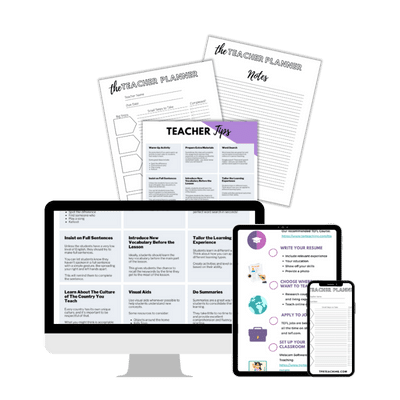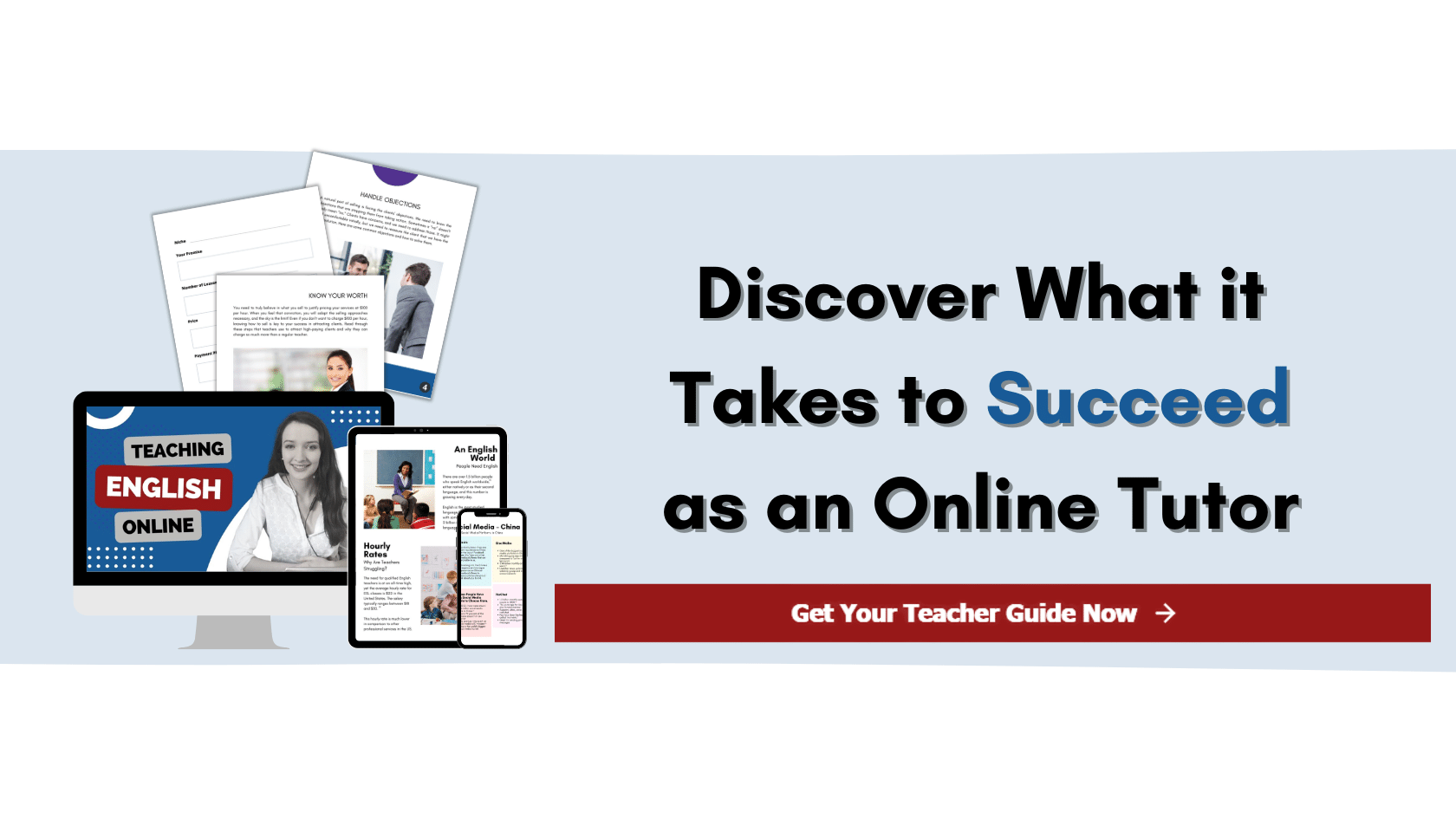Disclosure: This article may contain affiliate links, meaning that when you make a purchase, I earn a small commission. Affiliate links cost you nothing to use and help keep my content free. For more info, see the Disclosure Policy.
Teaching the English language is great fun, as it opens the way for communication and conversation. However, when you are teaching absolute or false beginners in English, it can take some extra work.
When teaching English to beginners, it is important to keep things simple and structured. Start by focusing on basic vocabulary and grammar concepts so that students feel comfortable with the language and gain an understanding of how it works.
Tips for Teaching Beginners
Here are some excellent tips to help you teach English to beginners for a more productive class:
1. Teach Beginner-Friendly Topics They Need to Know
When teaching English to beginners, it’s essential to focus on topics that are easy for them to understand. Think about what they need to know. For example, if they are adults, maybe they need to focus on basic introductions and nationalities. Then you may want to focus on teaching them the verb “to be.” For example, “I am from…” and “you are from…” This will give them the confidence to introduce themselves in English. You may then wish to focus on the possessive form (his name, my work, your family, etc.)
See: Awesome ESL Worksheets for Beginners
2. Don’t Assume What They Know
When teaching English to beginners, it’s important to remember that they may not have had any previous instruction or practice. Therefore, please don’t assume they know a certain grammar point or word. It’s better to explain everything from the beginning and move slowly so everyone can keep up.
3. Use Visuals
Visuals can be a great way to help students learn and remember new words. Use pictures, videos, flashcards, and other visuals to help reinforce English language concepts.
If you are teaching online, Manycam has many amazing graphics and images you can use to teach English. You can use the images live during your video calls as you speak.
Canva.com allows you to find and create beautiful and bold pictures and flashcards for free. Check out our free Alphabet ABC Chart if your students are new to the alphabet.
4. Use Repetition— And Plenty of it!
Repetition is critical when teaching English as a second language. Have students repeat words or phrases multiple times until they can say them comfortably. Break down new sentences into their parts and slowly build them back up again. This will help beginners to link the words together.
For example, the students learn the word “cat.” Then they learn “black cat.” They finally learn to make the sentence: “I see a black cat.”
Revise the new words and vocabulary at the end of the lesson or the start of the next lesson. Repeat them slowly and connect them to visuals or gestures so students know what you are talking about.
5. Speak in Shorter Sentences
When teaching English to beginners, it is important to keep sentences short and precise. Breaking long sentences into shorter ones will help them understand the meaning more easily. It is also a good idea to speak slowly and clearly so that your students can comprehend each word as they go along.
Please note that while the sentences should be short, they should also make grammatical sense. Speak in complete sentences, not broken English sentences, as this can add confusion.

For English Language Teachers or Those Looking to Get Started…
Teacher tips, new teacher checklist, teacher planner, and notes. Subscribe for ESL News, jobs, and more!
6. Use Total Physical Response (TPR)
TPR is a great way to teach and practice basic English language concepts. Use hand gestures or body movements to demonstrate the words that you are teaching. This will help learners link the spoken word with visual cues, helping them remember better and giving them another way to communicate.
When students learn a new word, they can repeat it while using TPR. This may look silly, but it will help them understand and remember the concept better.
7. Use Props
Props are a great way to make lessons more engaging and fun. Use real-life objects, toys, or food to help students practice the language. For example, if you teach to describe people in English, bring props such as hats or glasses, they can use while speaking.
Also, try using props to teach English words such as colors or numbers. You can bring toy animals and have the students name them using the correct English words.
8. Incorporate Music
Songs, chants, and rhymes are also great ways to help students learn English. Make it a daily habit to sing the alphabet, the months of the year, the parts of the body, or whatever topic you want your students to learn. You can also find fun and catchy songs online to help them learn.
9. Introduce New Words Slowly
Try introducing a few new words every day rather than bombarding students with too many at once. This will give them time to absorb and practice the material. Talk about the meaning of the new words, give examples, and try to connect them with prior knowledge.
10. Make it Fun
Preparing some fun activities for your classes can help keep your students focused and engaged. You can play beginner board games or word games like Word searches or Kahoot. You can play many games with your students in person and online. I like to play Shark Attack, drawing and guessing games, or Guess What I Am.
See: Fun Icebreaker Games and Activities For Students
11. Provide Feedback
Ensure students feel supported and encouraged in their language-learning journey by giving them timely, positive, and constructive feedback on their progress. Let them know when they do a job to build their confidence in learning the language.
There will be many things that could be improved at this level. Write down and correct the significant errors at the end of the activity or lesson to avoid disrupting their flow.
If you have young students, give them rewards such as stars. This helps motivate them to keep going. Here are some excellent creative reward systems you can incorporate into your teaching.
12. Be Patient
Teaching English to beginners can be challenging, so it’s important to remain patient with your students. Be willing to go over concepts multiple times if needed, and make sure that everyone is on the same page before moving on to new material.
13. Model What You Mean
Show what you mean, don’t just tell it. Modeling should give the students an idea of the expectations for a task. For example, when introducing the alphabet, you can demonstrate how to form a letter before getting the students to do it with you. This will help them understand what they are supposed to do, and they should be able to do it themselves.
14. Use Concept-Checking Questions
When teaching English to beginners, you should use concept-checking questions to ensure the students understand the material and can apply it. For example, after introducing a vocabulary word such as “apple,” you could ask a simple question like “What color is the apple?” or “What do you see on the trees in the picture?”
Use who/where/what/when/why/how questions and yes/no questions at the beginner level.
15. Provide Basic Classroom Language
Provide your students with useful phrases such as “Can you repeat that?”, “What does ______ mean?” and “I don’t understand.” This will help them if they get confused and don’t know how to ask for help. It is also important to provide some polite phrases, such as “Please” and “Thank you,” so they can learn the basics of conversation.
16. Engage More Advanced Students
If you have students in your class who are more advanced than the others, it’s a good idea to prepare some extra activities for them, so they don’t get bored and lose enthusiasm. Encourage them to take the lead in modeling to the other students what to do in the exercise, engage them with peer-learning activities, or ask them more challenging questions.
17. Prepare More Lesson Material Than You Need
Preparing some extra lesson material will come in handy if your students need more practice on a certain topic. This way, you can provide them with additional activities and exercises to help them better understand the material. You can also prepare supplemental materials such as videos or worksheets they can use at home or during their free time.
Make sure to clearly explain any new vocabulary or grammar point, practice what they have learned with some exercises, and prepare for any possible questions they may have. Teaching beginners can frequently be more work than teaching other language learning levels because they cannot engage in many conversations. Simplify the work and don’t overwhelm them.
18. Involve the Students in Group Activities
Group activities can help students practice their English skills in a more comfortable and relaxed environment. Activities like role-playing games, charades, or other interactive exercises are great for beginners. You can also have the students read out loud to each other or watch English movies together. This will help them become more confident and enjoy learning the language.
19. Smile and be Animated
Smiling and being animated will help your students stay engaged, interested and motivated. Use hand gestures and facial expressions to emphasize points to make the class more fun. Make your classroom a place where students want to be. Add some personality to the lessons and stay positive! Students love being around this energy.
Conclusion
Teaching English to beginners can be a rewarding experience. By following these tips, you can help inspire your students and help them progress in their language-learning journey. If you need additional help, a TEFL certification course will give you a better understanding of how to teach English to any group level or age. Have fun and stay creative when teaching the basics of English!
Online Teacher Toolkit
Be IN The Know
Get the latest jobs, news, and opportunities delivered directly to your inbox by joining my exclusive community. Grab my teacher planner, teacher checklist and tips now. Sign up here.
GEt Certified
Start your teaching journey and get certified now. Watch my YouTube video about how I got started, or read about my experience here: The TEFL Academy review.
START Your First Teaching JOb
New to the world of online teaching or just want to fill some hours in? Curious if this is a career you want to pursue? Check out Cambly to get started. Read the Cambly review.
Highest-Paying Online Teaching Jobs
In my post, I cover a list of some of the highest-paying online teaching jobs. Alternatively, use the curriculum online and find your own students. It’s easier than you think!
ACCEPT PAYMENTS ONLINE and Save money
Use Wise to accept payments from overseas. Wise has the lowest exchange rates that I am currently using right now. Get Wise.
Caitriona Maria is an education writer and founder of TPR Teaching, crafting inspiring pieces that promote the importance of developing new skills. For 7 years, she has been committed to providing students with the best learning opportunities possible, both domestically and abroad. Dedicated to unlocking students' potential, Caitriona has taught English in several countries and continues to explore new cultures through her travels.


